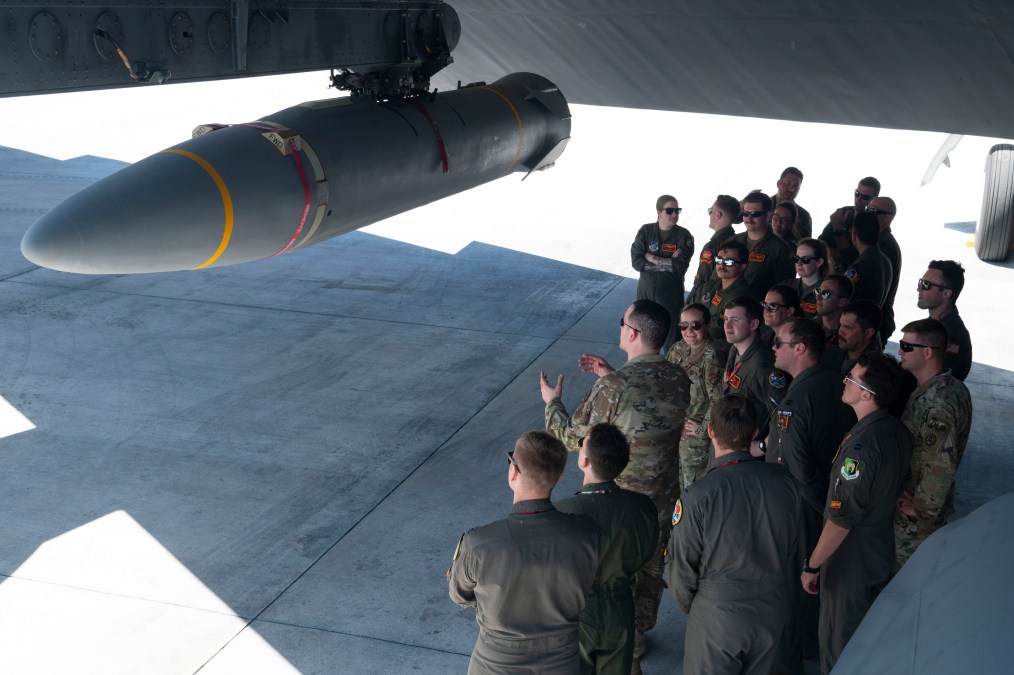Air Force not planning to buy any ARRW hypersonic missiles in fiscal 2025

The Air Force doesn’t intend to procure or continue research and development of the AGM-183A Air-Launched Rapid Response Weapon (ARRW) in the fiscal 2025 budget — although the service has not determined whether or not it will end the program altogether.
According to Defense Department budget documents for FY ’25 released Monday, the Air Force has not requested any procurement funding for the Lockheed Martin-made hypersonic missile. Instead, the service will wrap up the final flight test budgeted for the program in fiscal 2024 and then decide ARRW’s fate once all the data from the testing campaign has been analyzed, an Air Force spokesperson said in a statement.
“The Air Force remains committed to fully analyzing and understanding all test data gathered while conducting the ARRW Rapid Prototyping test series. This data will inform subsequent development and fielding decisions with ARRW,” the spokesperson said in an email.
Developing hypersonic missiles has been a top priority for the Air Force and other services as U.S. adversaries continue to mature their own technology. The weapons are able to reach speeds of Mach 5 or higher and are highly maneuverable in-flight, making them difficult for air defense systems to intercept them.
In its budget request for fiscal 2024, the Air Force asked for $150 million for ARRW to finish the rapid prototyping program and conduct flight tests of the missile. R&D funding was expected to end in FY ’24, after which the service would revisit the program’s funding for fiscal 2025.
The lack of funding in FY ’25 wasn’t a total surprise, as Air Force leaders have gone back-and-forth on the hypersonic missile’s fate in the last year. The program suffered a series of setbacks in 2023, including an all-up-round flight test in March 2023 that was deemed a failure by Air Force Secretary Frank Kendall. The service has held two more flight tests for ARRW — the results of which were not shared publicly — and is planning for one last test before the end of the month.
Although the Air Force has not publicly stated what caused the failures, a recent report from the Pentagon’s director of operational test and evaluation found that a lack of available infrastructure and insufficient means to collect data have impacted the service’s test campaign for ARRW.
“The hypersonic modernization area supports increased lethality for the Joint Force by providing responsive, lethal, and survivable effects from stand-off ranges,” the spokesperson said. “The goal is to enable the industrial base to manufacture affordable hypersonic systems and at the necessary capacity to achieve a decisive advantage on the battlefield.”
In the meantime, the Air Force will continue research and development for its other hypersonic missile program — the Hypersonic Attack Cruise Missile (HACM). Whereas ARRW is a boost-glide system that uses a rocket to reach high speeds, HACM is an air-breathing scramjet weapon.
The service has requested $517 million for HACM’s development in fiscal 2025, according to budget documents. While that is more than the $381.5 million requested by the service in fiscal 2024, last year’s proposal to Congress indicated that the service planned to ask for $557.1 million in R&D funding in FY ’25.
Raytheon has been the prime contractor for HACM since 2022, when it received a $985 million contract from the service for design, development and initial delivery of the missile by March 2027. In January, the company received an additional $407.6 million from the Air Force to conduct concurrent R&D work that will enhance the system.






